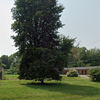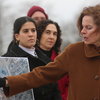Preservation begins to reflect greater diversity as Rapp Road District named to 'Seven to Save'
For many, it’s a shortcut on the way home from work. For others, it’s the home where their families have lived for at least 75 years and an important piece of African-American living cultural history.
The small wooden homes that line Rapp Road and Springsteen Road, tucked between Western Avenue and Washington Avenue Extension, are not the sort of grand structures typically listed on the national and state registries of historic districts. But they are included on both.
This month, the Rapp Road Historic District was also named to the list of “Seven to Save” of important threatened buildings or districts selected by the New York State Preservation League.
“We know our history, we live our history,” said Beverly Bardequez, a spokeswoman. “We had not always thought of it as a history that goes beyond the community.”
The Rapp Road Historic District grew up during the Great Migration, when about 6 million blacks followed opportunity, moving from the South to the North and to large cities in other parts of the country between 1910 and 1970.
The Rapp Road community, located partly in the town of Guilderland and partly in the panhandle of Albany, was settled between about 1930 and 1960. The fact that it remains largely intact — with at least 12 families descended from the original settlers’ 23 families still living in the homes — makes it rare.
So does, said Susan Herlands Holland, the fact that this is “one of the few remaining sites in the country outside of large cities.” Herlands Holland is executive director of Historic Albany Foundation, which nominated the area for the “Seven to Save” designation.
The community was formed by Pastor Louis Parson of the Church of God in Christ in Shubuta, Mississippi and his congregants who followed him to the northeast. The group settled first in Albany’s South End but found it to be riddled with drugs, drinking, and prostitution. They soon moved west to the rural and undeveloped Rapp Road area, where they could “continue their Southern way of life,” Herlands Holland said.
As suburbs grew in what had been pine barrens, the area became vulnerable to encroachment by developers. Bardequez lives at 14 Rapp Rd. and is descended from original settlers. She told The Enterprise, “We’re constantly trying to put out fires of people wanting to come in and change the face of the community. As they see it, these are just little bungalows along the road that are not worth much, that are in disrepair and need to be torn down.”

When developers see an opportunity to buy, Bardequez said, “They will pounce on it and let it [the house] sit there until they are able to do something with it.”
Herlands Holland said that the preservation movement started with saving Mount Vernon and has its roots in what is typically called “white man’s history.” Going forward, she said, “Our historic sites, monuments, and parks must reflect the diversity of our places, cultures, and peoples more comprehensively.”
Sometimes, stories of diversity might not have the same thorough documentation as other sites. But Rapp Road is very well documented, said Herlands Holland, through the stories of the descendants, many of which are recorded in the book “Southern Life, Northern City: The History of Albany’s Rapp Road Community” (Excelsior Editions, 2008) by Jennifer A. Lemak. Lemak, who is now Chief Curator of History at the New York State Museum, told The Enterprise, soon after her book was published, that the community will retain its designation as a historic district until the features that put it on the register disappear. These of course include the buildings themselves.
Whenever a house goes up for sale, Lemak said recently, the residents “really try to recruit family members to come and live there.”
Residents are keen to keep homes within the original families, Bardequez confirmed. She said that 8 Rapp Road, alongside South Frontage Road, was in the midst of being torn down before she realized what was going on.
She is determined not to let that happen again. That house was the first residence built in the area, and it was also used as a prayer meeting house.
Pyramid Management Group, the owners of Crossgates Mall, have bought one piece of property — with no house on it — within the community, Bardequez said. DeThomasis Property Management, which already owned 1 Rapp Road, bought the house next door to it. They did not tear down the original house, Bardequez said — “they would have a riot on their hands if they did” — but they managed to “squeeze in” between those two structures, she said, a tall and narrow brick mixed-use office and residential building,
The house next door to her was recently put on the market and an offer was made by someone from outside the community.
Another on the street is currently for sale; the owner, who was 100 years old, died in the spring of 2015. Residents are trying to find a family member to purchase it, she said.
Bardequez said, “I’m third-generation, and I have fourth and fifth generations living in my household also. There are several other families like that here too.”
The community was chartered in 2006 as a not-for-profit organization, called the Rapp Road Historical Association, so that it could do fundraising, Bardequez said. “Our mission is to keep the Rapp Road community a historic community,” she said. “We are trying to keep our heritage and legacy going.”
The group hopes to achieve that by raising the funds to buy any empty homes — restoring those that are in disrepair and creating a visitors’ center in the community.
“The association does not have a physical location at this time,” Bardequez said. “Our goal is to have a visitors’ center that will tell the history of the community.”
Erin Tobin, director of preservation with the New York State Preservation League said that there have been many “success stories” of places that have received the organization’s Seven to Save designation and gone on to leverage it to help in their fundraising efforts. One of these, said Tobin, is Wellington Row in Albany, which received the designation in 2000, “back when the buildings were threatened with demolition” and which has gone on to see “tremendous investment recently and which is now almost totally occupied.”
Herlands Holland said that Historic Albany Foundation hopes to secure an agreement with one of several not-for-profit organizations that brings together young people who want hands-on training and experience in preservation and construction with historic buildings that need rehabilitation, as part of the effort to stabilize and then restore the four buildings that are currently empty.
The Seven to Save designation is important, says Bardequez, because it “recognizes that we are a historic site that is worthy of being saved.”
****
A fundraiser, “Honoring the Past, Preserving the Future,” is planned for Thursday, April 14, from 5 to 8:30 p.m. at SUNY Polytechnic Institute’s Smart Cities Technology Innovation Center (SCITI) at Kiernan Plaza on Broadway in Albany.
The event will include hot hors d’oeuvres by Mazzone Catering; a cash bar; remarks from Michael Francher, Vice President of Business Development and Economic Outreach at SUNY Polytechnic Institute, and Susan Herlands Holland, Executive Director, Historic Albany Foundation; a photo essay and video on the Rapp Road Community; and music by Tara and the Wilborn Temple Combined Choir. Entry is by donation, with the suggested donation starting at $50.
The Rapp Road Historical Association offers tours in the spring and summer. Groups or individuals who want to visit are welcome. There is no set charge, although the group does ask for a donation. Please contact [email protected].
The group also usually holds one public lecture and tour at some point in the summer, Bardequez said. To receive updates about events, “like” and “follow” the group’s Facebook page.


